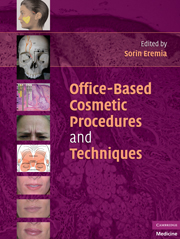Book contents
- Frontmatter
- Contents
- PREFACE
- CONTRIBUTORS
- PART ONE ANATOMY AND THE AGING PROCESS
- PART TWO ANESTHESIA AND SEDATION FOR OFFICE COSMETIC PROCEDURES
- PART THREE FILLERS AND NEUROTOXINS
- PART FOUR COSMETIC APPLICATIONS OF LIGHT, RADIOFREQUENCY, AND ULTRASOUND ENERGY
- Chap. 42 TREATMENT OF TELANGIECTASIA, POIKILODERMA, AND FACE AND LEG VEINS
- Chap. 43 VASCULAR LASERS
- Chap. 44 OVERVIEW OF CO2 AND ER:YAG LASERS AND PLASMA DEVICES
- Chap. 45 CONTEMPORARY CO2 LASER RESURFACING
- Chap. 46 ER:YAG
- Chap. 47 PLASMA SKIN REJUVENATION OF THE HANDS
- Chap. 48 NONABLATIVE LASER TISSUE REMODELING: 1,064-, 1,320-, 1,450-, AND 1,540-NM LASER SYSTEMS
- Chap. 49 OVERVIEW OF BROADBAND LIGHT DEVICES
- Chap. 50 TITAN: INDUCING DERMAL CONTRACTION
- Chap. 51 SCITON BROADBAND LIGHT AND ER:YAG MICROPEEL COMBINATION
- Chap. 52 AMINOLEVULINIC ACID PHOTODYNAMIC THERAPY FOR FACIAL REJUVENATION AND ACNE
- Chap. 53 THERMAGE FOR FACE AND BODY
- Chap. 54 LUMENIS ALUMA SKIN TIGHTENING SYSTEM
- Chap. 55 ELLMAN RADIOFREQUENCY DEVICE FOR SKIN TIGHTENING
- Chap. 56 ALMA ACCENT DUAL RADIOFREQUENCY DEVICE FOR TISSUE CONTOURING
- Chap. 57 COMBINED LIGHT AND BIPOLAR RADIOFREQUENCY
- Chap. 58 FRACTIONAL LASERS: GENERAL CONCEPTS
- Chap. 59 PALOMAR LUX 1,540-NM FRACTIONAL LASER
- Chap. 60 FRAXEL 1,550-NM LASER (FRAXEL RE:STORE)
- Chap. 61 1,440-NM FRACTIONAL LASER: CYNOSURE AFFIRM
- Chap. 62 SCITON ER:YAG 2,940-NM FRACTIONAL LASER
- Chap. 63 ALMA PIXEL ER:YAG FRACTIONAL LASER
- Chap. 64 FRACTIONATED CO2 LASER
- Chap. 65 LED PHOTOREJUVENATION DEVICES
- Chap. 66 PHOTOPNEUMATIC THERAPY
- Chap. 67 HAIR REMOVAL: LASER AND BROADBAND LIGHT DEVICES
- Chap. 68 ACNE AND ACNE SCARS: LASER AND LIGHT TREATMENTS
- Chap. 69 FAT AND CELLULITE REDUCTION: GENERAL PRINCIPLES
- Chap. 70 ULTRASHAPE FOCUSED ULTRASOUND FAT REDUCTION DEVICE
- Chap. 71 LIPOSONIX ULTRASOUND DEVICE FOR BODY SCULPTING
- PART FIVE OTHER PROCEDURES
- INDEX
- References
Chap. 54 - LUMENIS ALUMA SKIN TIGHTENING SYSTEM
from PART FOUR - COSMETIC APPLICATIONS OF LIGHT, RADIOFREQUENCY, AND ULTRASOUND ENERGY
Published online by Cambridge University Press: 06 July 2010
- Frontmatter
- Contents
- PREFACE
- CONTRIBUTORS
- PART ONE ANATOMY AND THE AGING PROCESS
- PART TWO ANESTHESIA AND SEDATION FOR OFFICE COSMETIC PROCEDURES
- PART THREE FILLERS AND NEUROTOXINS
- PART FOUR COSMETIC APPLICATIONS OF LIGHT, RADIOFREQUENCY, AND ULTRASOUND ENERGY
- Chap. 42 TREATMENT OF TELANGIECTASIA, POIKILODERMA, AND FACE AND LEG VEINS
- Chap. 43 VASCULAR LASERS
- Chap. 44 OVERVIEW OF CO2 AND ER:YAG LASERS AND PLASMA DEVICES
- Chap. 45 CONTEMPORARY CO2 LASER RESURFACING
- Chap. 46 ER:YAG
- Chap. 47 PLASMA SKIN REJUVENATION OF THE HANDS
- Chap. 48 NONABLATIVE LASER TISSUE REMODELING: 1,064-, 1,320-, 1,450-, AND 1,540-NM LASER SYSTEMS
- Chap. 49 OVERVIEW OF BROADBAND LIGHT DEVICES
- Chap. 50 TITAN: INDUCING DERMAL CONTRACTION
- Chap. 51 SCITON BROADBAND LIGHT AND ER:YAG MICROPEEL COMBINATION
- Chap. 52 AMINOLEVULINIC ACID PHOTODYNAMIC THERAPY FOR FACIAL REJUVENATION AND ACNE
- Chap. 53 THERMAGE FOR FACE AND BODY
- Chap. 54 LUMENIS ALUMA SKIN TIGHTENING SYSTEM
- Chap. 55 ELLMAN RADIOFREQUENCY DEVICE FOR SKIN TIGHTENING
- Chap. 56 ALMA ACCENT DUAL RADIOFREQUENCY DEVICE FOR TISSUE CONTOURING
- Chap. 57 COMBINED LIGHT AND BIPOLAR RADIOFREQUENCY
- Chap. 58 FRACTIONAL LASERS: GENERAL CONCEPTS
- Chap. 59 PALOMAR LUX 1,540-NM FRACTIONAL LASER
- Chap. 60 FRAXEL 1,550-NM LASER (FRAXEL RE:STORE)
- Chap. 61 1,440-NM FRACTIONAL LASER: CYNOSURE AFFIRM
- Chap. 62 SCITON ER:YAG 2,940-NM FRACTIONAL LASER
- Chap. 63 ALMA PIXEL ER:YAG FRACTIONAL LASER
- Chap. 64 FRACTIONATED CO2 LASER
- Chap. 65 LED PHOTOREJUVENATION DEVICES
- Chap. 66 PHOTOPNEUMATIC THERAPY
- Chap. 67 HAIR REMOVAL: LASER AND BROADBAND LIGHT DEVICES
- Chap. 68 ACNE AND ACNE SCARS: LASER AND LIGHT TREATMENTS
- Chap. 69 FAT AND CELLULITE REDUCTION: GENERAL PRINCIPLES
- Chap. 70 ULTRASHAPE FOCUSED ULTRASOUND FAT REDUCTION DEVICE
- Chap. 71 LIPOSONIX ULTRASOUND DEVICE FOR BODY SCULPTING
- PART FIVE OTHER PROCEDURES
- INDEX
- References
Summary
Skin tightening devices have become some of the most popular cosmetic procedures patients are currently asking cosmetic dermatologists to perform in their offices. These devices have been developed to augment many of the other noninvasive cosmetic procedures we are performing on a regular basis in our office settings. They have introduced new terms into our laser vocabulary, which now has to be expanded into the new field of energy-based systems. These energy-based systems utilize terms such as monopolar, unipolar, bipolar radiofrequency (RF), and tripolar. The RF devices that have been developed for skin tightening, as well as several other devices that rely on the absorption spectrum of water in the infrared range of light, allow sufficient deep dermal heating to produce the desired effects. All the skin tightening devices on the market work via the same basic premise: deep dermal heating, which causes collagen denaturation, followed by collagen repair and ultimate deposition of new collagen and, ultimately, skin tightening. The major skin-tightening devices available on the market at the time of this writing are shown in Table 54.1.
RF energy produces a thermal effect when its high-frequency electrical current moves through the skin. The amount of heat generated in the tissue of the skin can be described by the mathematical formula known as Joule's law: H = j2/σ, where j is the density of the electrical current and σ is the specific electrical conductivity. The tissue impedance, or resistance, is inversely proportional to the electrical conductivity.
- Type
- Chapter
- Information
- Office-Based Cosmetic Procedures and Techniques , pp. 246 - 249Publisher: Cambridge University PressPrint publication year: 2010



